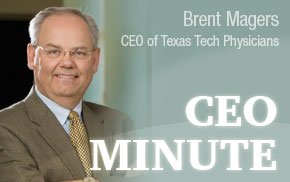 Even in this digital age, I still enjoy reading newspapers and usually read at least
two every day (the “Wall Street Journal” is my favorite). I do enjoy kicking back
on Sunday afternoons and reading newspapers when I have plenty of time. Often the
“Wall Street Journals” pile up during the week, and Sunday is a good time to tackle
the pile. I also enjoy reading the “Lubbock Avalanche-Journal.” In reading this past
Sunday’s “A-J,” I could not help but notice seven large advertisements announcing
new physicians in Lubbock. Then I noticed something else — seven of seven either had
graduated from the Texas Tech University Health Sciences Center School of Medicine
or did their residency here. Our school, brought into existence in 1969 by Gov. Preston
Smith and others, is fulfilling its mission of alleviating a chronic shortage of physicians
in our area. That is a source of pride for all of us.
Even in this digital age, I still enjoy reading newspapers and usually read at least
two every day (the “Wall Street Journal” is my favorite). I do enjoy kicking back
on Sunday afternoons and reading newspapers when I have plenty of time. Often the
“Wall Street Journals” pile up during the week, and Sunday is a good time to tackle
the pile. I also enjoy reading the “Lubbock Avalanche-Journal.” In reading this past
Sunday’s “A-J,” I could not help but notice seven large advertisements announcing
new physicians in Lubbock. Then I noticed something else — seven of seven either had
graduated from the Texas Tech University Health Sciences Center School of Medicine
or did their residency here. Our school, brought into existence in 1969 by Gov. Preston
Smith and others, is fulfilling its mission of alleviating a chronic shortage of physicians
in our area. That is a source of pride for all of us.We are doing our part for West Texas — but, is it enough? The Association of American Medical Colleges (AAMC) estimates that in 2015 our country will have 62,900 fewer doctors than needed. Furthermore, that number will more than double by 2025. Reasons include the expansion of insurance coverage and, as I have mentioned before, the aging of baby boomers, which is driving up demand for health care. It is the graying of America and all of that rubbish, as the British would say. (I’ve been watching the Olympics, too).
Seriously, the shortfall of doctors in 2025 will exceed 100,000, according to the AAMC, and — this is the disturbing part — there is really not much that can be done to address the need in a timely fashion since it typically takes a decade to train a doctor.
The good news is that enrollments are increasing both here and at other medical schools. The not so good news — enrollment growth is not keeping up with population growth. TTUHSC will welcome 150 new medical students Aug. 6. We want to all be sure they are all made to feel welcome. A final quick thought, our country also needs to address the number of residency slots — this is just as or more important than increasing spots in medical schools, but so far there is no evidence it is occurring. In fact, for 15 years, a bottleneck in the training pipeline has limited new doctors. The federal Balanced Budget Act of 1997 capped funding for graduate medical education, limiting the number of medical resident positions nationwide to 100,000 and that number is not budging much at all.
